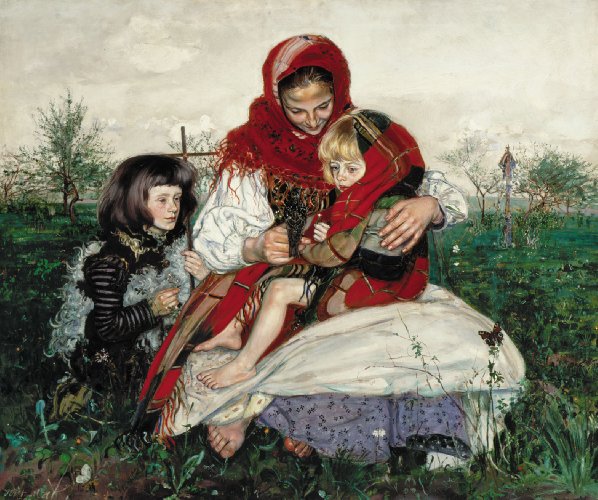Description:
Wlastimil Hofman (1881-1970), an artist with a foreign-sounding name, dedicated his life and creativity to Poland. His mother was Polish and his father was Czech. Over time he polish his name from Vlastimil Hoffmann to Wlastimil Hofman. He studied at the Academy of Fine Arts in Krakow and the École des Beaux-Arts in Paris. He was greatly influenced by the painting of his teacher, Jacek Malczewski. Like his master, he combined religious and fantastic elements with everyday life. However, Hofman’s work took on its own character. In his pursuit of the renewal of religious art, which was one of his most important artistic goals, traditional Christian iconographic patterns were used to depict the life of the simple people*.
Description of the painting:
“Mother of God (Madonna with a sparrow)” is considered one of the most beautiful works of art by Hofman. He transferred the familiar type of representation of the Madonna with the Child to the Krakow reality. The foreground is occupied by three figures compositionally closed in a triangle, referring to the scheme of the Sacra Conversazione, in which the Virgin Mary with the Child was shown in the company of saints. The dominant figure is a woman sitting on the grass with her legs bent. She is dressed in Krakow folk costume, but there are also references to the iconography of Mary, as the colors red, white and blue are assigned to the garments of the Mother of God. The woman’s head is wrapped in a red scarf, which symbolizes love but also suffering. In the context of Mary, this color can be interpreted as a sign of a caring mother’s love for Jesus and people, but also as a foreshadowing of the suffering she will experience. White on the shirt and skirt is the color of purity and innocence. At the very bottom of the ground, a blue color is also used, which can be interpreted as a symbol of heaven. Bare feet appear under the skirt, emphasizing the peasant origin of the figure. She bends over the frozen boy sitting on her lap. The fabric’s dominant color is red, which in Christian symbolism foreshadows the Savior’s martyrdom. On the woman’s left knee is a butterfly, which symbolizes the soul and resurrection. Hofman thus included symbols speaking of the future of Christ in the work. The titular Madonna encircles the boy with her left arm. On her right hand, however, there is a sparrow, which she is showing the child. It is possible that the bird is a reference to the wagtail, which appears in representations of Jesus as a child and foreshadows his martyrdom. Here, however, the sparrow seems to be a reference to the folk character of the work. The bird is very popular in Poland, often seen in orchards. This corresponds to the space in which the scene is set. Sparrows are also one of the first birds to appear after winter, so it can be interpreted as a symbol of spring and the awakening of nature, which is confirmed by the view in the background. The bird is a figure connecting all figures on the canvas, their gaze is focused on it. The third figure contained in the work is a boy kneeling on the left side of the picture field. He seems frail, and his face is exceptionally pale. Through a black costume, he clearly stands out from the mother and child. His attributes allow him to be identified as John the Baptist. He is girded with fur, which is supposed to refer to the camel’s skin worn by the saint. Attention is also drawn to the boy’s lush black hair. From the Holy Scripture we know that John the Baptist was a Nazarite – a person who made a perpetual vow of full devotion to God. One of the obligations of the vow was not to cut hair and beard during its duration. He presses his right hand to his chest and holds a long cross in his left hand. Looking at how the figure of the Mother and the boy sitting on her lap is composed, one can get the impression that it compositionally resembles the figure of piety. Sitting Mother of God, bowing her head, holds in her arm the body of Jesus taken from the cross. Characteristic for this type of representation seems to be the arrangement of legs – bent, falling from the mother’s knee. A similar arrangement is visible in the painting of Hofman. The clear separation of John the Baptist’s figure may emphasize this intention.
The scene is set in an open space of a garden in early spring. In the distance, the trees are covered with green. On the right side of the image there is a chapel on a pillar. Probably there is a figure of Christ inside. Chapels were also once placed in places of revelations. It seems that the artist wanted to give the viewer an understanding that beneath the presented rural and maternal love scene on the foreground, there is a scene from the life of the Savior.


